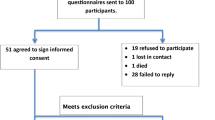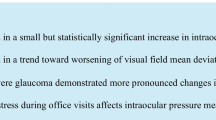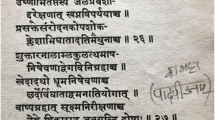Abstract
Personality profile, psychophysical stress and cycloplegic refraction were evaluated at the baseline (TO) and after 12 months (T1) in 57 university students comprising 39 myopes and 18 emmetropes/hyperopes (controls) whose age, sex distribution and academic results were comparable. At TO, a tendency toward a higher degree of anxiety, somatization and inadequacy was found in myopes in comparison with controls; however, only the anxiety state was different (Wilcoxon signed-rank testP<0.001). Personality profiles, psychophysical stress and blood levels of cortisol, ACTH, GH, prolactin were similar in myopes and controls. The myopes were classified at T1 as either well-corrected (if their lenses corresponded to refractometer values of ± 0.50 D and were worn full-time) or undercorrected (if their lenses were ≥ 0.75 D with respect to refractometric values and/or were worn part-time). When the spherical cycloplegic values at TO and T1 were compared, a myopic shift was revealed only in the undercorrected myopes (P< 0.001 in both eyes). These findings suggest that personality profile and psychophysical stress do not play a primary pathogenetic role in myopia. Undercorrection seems to accelerate the progression of myopia.
Similar content being viewed by others
References
Angi MR (1991) Pre-retinal focusing of images conditions eye growth. Boll Ocul 70 [Suppl 2]:283–297
Angi MR, Gianelli G, Plebani M, Tagliapietra S, Turrini B, Pucci V, Rupolo GP (1991) Myopia, personality and psychosomatic stress: a study on 87 university students. Boll Ocul 70 [Suppl 3]:299–307
Angi MR, Pucci V, Forattini F, Formentin PA (1992) Results of photorefractometric screening for amblyogenic defects in children aged 20 months. Behav Brain Res 49:91–97
Ashton GC (1985) Segregation analysis of ocular refraction and myopia. Hum Hered 35:232–239
Balacco Gabrieli C (1982) Aetiopathogenesis of degenerative myopia. A hypothesis. Ophthalmologica 185:199–204
Birnbaum MH (1988) Undercorrection and myopia development. Am J Opt Phys Opt 65:974–975
Cattel RB, Saunders DR, Stice GF (1950) The 16 personality factor test. Institute of Personality and Ability testing, Champaign, Ill
Cohn SJ, Cohn CM, Jensen AR (1988) Myopia and intelligence: a pleiotropic relationship? Hum Genet 80:53–58
Curtin BJ (1985) The myopias: basic science and clinical management. Harper & Row, Philadelphia
Ebenholtz SM (1983) Accommodative hysteresis: a precursor for induced myopia? Invest Ophthalmol Vis Sci 24:513–514
Fulton AB, Hansen RM, Petersen RA (1982) The relation of myopia and astigmatism in developing eyes. Ophthalmology 89:298–302
Gawron VJ (1983) Ocular accommodation, personality and autonomic balance. Am J Optom Phys Opt 60:630–639
Gellhorn E (1953) Physiological foundations of neurology and psychiatry. University of Minnesota Press, Minneapolis, pp 337–338
Kellner R, Sheffield BF (1973) A self-rating scale of distress. Psychological Med 3:88–94
Leibowitz HW (1977) Visual perception and stress. In: Borg G (ed) Physical work and effort. Wenner Gren Center, Pergamon Press, New York, pp 25–37
Miller-Meeks MJ, Bennett SR, Keech RV, Blodi CF (1990) Myopia induced by vitreous hemorrhage. Am J Ophthalmol 109:199–203
Pärssinen O, Hemminki E, Klemetti A (1989) Effect of spectacle use and accomodation on myopic progression: final result of a three-year randomised clinical trial among school children. Br J Ophthalmol 73:547–551
Paykel ES, Emms E, Fletcher J, Rassaby ES (1980) Life events and social support in puerperal depression. Br J Psychiatry 136:339–451
Rabin J, Van Sluyters RC, Malach R (1981) Emmetropization: a vision-dependent phenomenon. Invest Ophthalmol Vis Sci 20:561–564
Rosanes MB (1967) Psychological correlates to myopia compared to hyperopia and emmetropia. J Progr Technol 315:31–36
Rosner M, Belkin M (1987) Intelligence, education and myopia in males. Arch Ophthalmol 105:1508–1511
Sperduto RD, Seigel D, Roberts J, Rowland M (1983) Prevalence of myopia in United States. Arch Ophthalmol 101:405–407
Spielberger CD, Gorsuch RL, Lushene R, Vagg PR, Jakobs GA (1980) Manual for the State-Trait Anxiety Inventory (form Y). Consulting Psychology Press, Palo Alto
Takayama H (1974) The effect of glasses correcting corneal astigmatism on refractive components. Acta Soc Ophthalmol Jpn 78:220–236
Troilo D, Wallman J (1991) The regulation of eye growth and refractive state: an experimental study of emmetropization. Vision Res 31:1237–1250
Wiesel TN, Raviola E (1977) Myopia and eye enlargement after neonatal lid fusion in monkeys. Nature 266:66–68
Williams RB Jr, Lane JD, Kuhn CM, Melosh W, White AD, Schanberg SM (1982)Type A behavior and elevated physiological and neuroendocrine responses to cognitive tasks. Science 218:483–485
Author information
Authors and Affiliations
Rights and permissions
About this article
Cite this article
Angi, M., Rupolo, G., De Bertolini, C. et al. Personality, psychophysical stress and myopia progression. Graefe's Arch Clin Exp Ophthalmol 231, 136–140 (1993). https://doi.org/10.1007/BF00920935
Received:
Accepted:
Issue Date:
DOI: https://doi.org/10.1007/BF00920935




